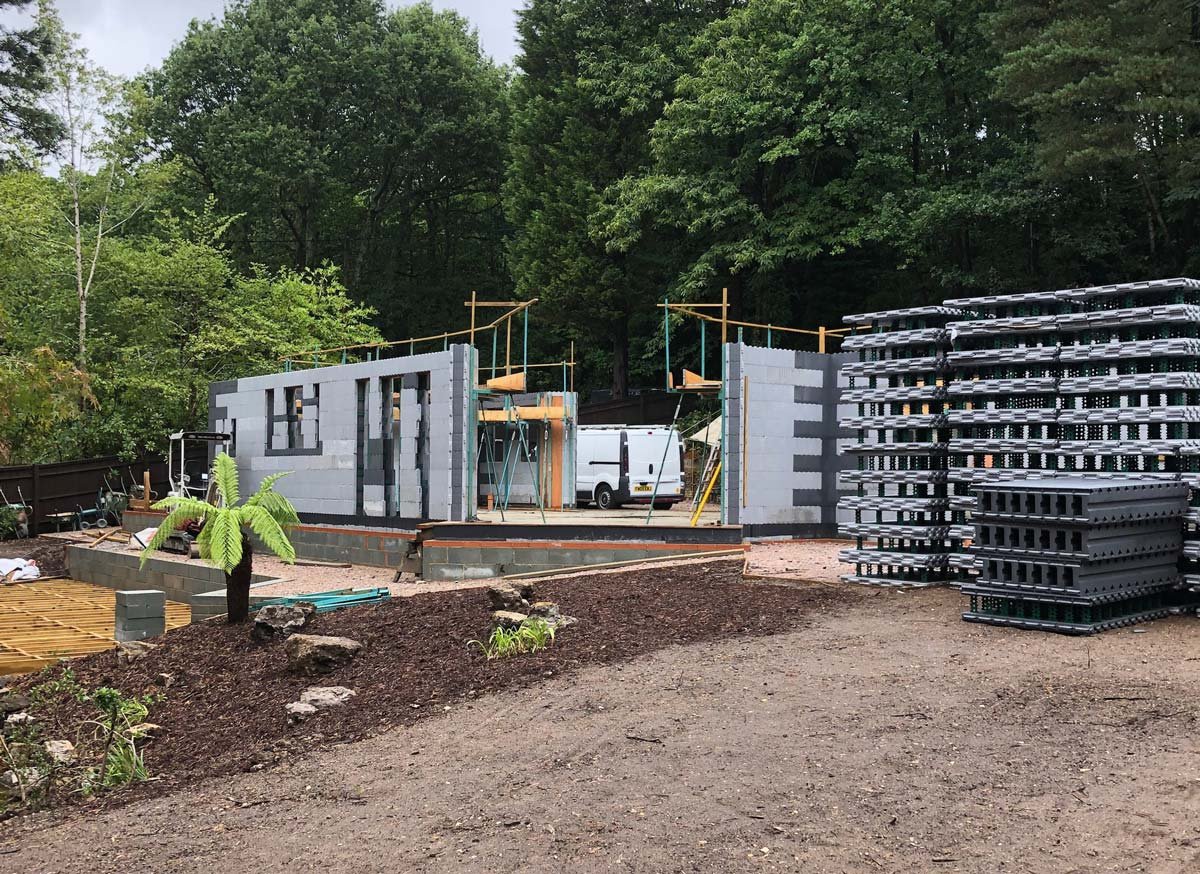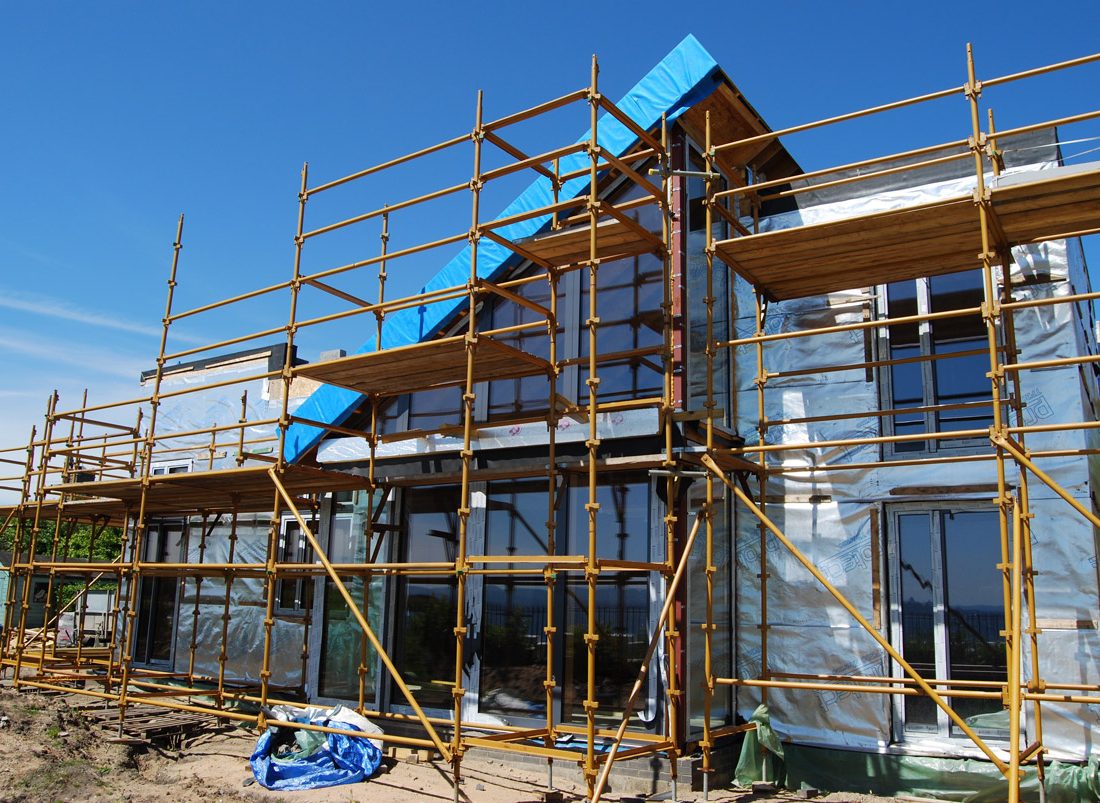With the variety of construction methods available to today’s self-builders, it can be a minefield when trying to decide which one is best suited to your build. When setting out your design brief with an architect, the construction method that you select can strongly influence many aspects of your build.
The following guide is designed to help potential self-builders gain an understanding of which construction method best suits their needs.
- Construction methods – Which ones should I consider?
- What construction type is best for the site I have?
- I’m working on a tight budget. What construction method is best for my build?
- Modern Methods of Construction vs Traditional?
- Does my construction selection affect my design?
- What is the most sustainable construction type?
- Which is the cheapest method of construction?
- Can I get a mortgage or a warranty for all modern methods of construction (MMC)?
1. CONSTRUCTION METHODS – WHICH ONES SHOULD I CONSIDER?
A lot of what we do here at AC Architects includes modern methods of construction because they’re a lot quicker on-site, reducing site time and costs. With many modern methods, you can get the design signed off in the factory first, allowing you to order windows and doors at the same time as your kit, further reducing time on site.
ACA work closely with many companies that supply Modern Methods of Construction, such as Timber Frame, SIPS panels (Structural insulated Panels) and ICF (Insulated Concrete Formwork). These systems are commonly used as they are low energy and follow the Fabric First Approach.
With all of these systems, your design can be set by your Architect to suit standard increments or panel sizes, allowing the contractor or manufacturer to offer you the most efficiency in your kit. They can also set out the kit on site to form the apertures required, whether that be prefabricated in the factory or linked to standard unit sizes. Working with a trusted contractor helps achieve this on-site.
Modern methods are really beneficial because they’re low energy, Fabric First and much quicker than most traditional methods of construction. They also come with high levels of air tightness and thermal efficiency, which helps achieve the more stringent levels now imposed by regulations.
2. WHAT CONSTRUCTION TYPE IS BEST FOR THE SITE I HAVE?
The first thing you want to do is get the site measured through a topographical surveyor. This will explore the levels, terrain and surrounding area of your site and will give your Architect a better understanding of your site so they can suggest and envisage what options may be best suited for the site conditions.
We would also advise you to get a Structural engineer to review your site to determine what your ground conditions are. Many factors can be considered by the Engineer at this stage, which include but are not limited to ground-bearing capacity, porosity, and water table level. All of these influence and should be considered with your Architect to determine the construction method that you select.

3. I’M WORKING ON A TIGHT BUDGET. WHAT CONSTRUCTION METHOD IS BEST FOR MY BUILD?
If you are working on a tight budget, you will want to consider construction methods that are cost-effective as well as ones that you could potentially construct on site yourself.
A lot of construction methods can be made more cost-effective by working with your Architect and Engineer, as mentioned above. Your Engineer can also mark up some value Engineering on the design to make potential cost-saving suggestions.
An open panel timber frame could be a cost-effective option as the kit is supplied prefabricated with the insulation supplied loose. This reduces the fabrication cost in the factory and can be installed through a local contractor or even fitted yourself.
We have even had clients setting out ICF blocks on-site themselves.
Any system that removes a process in the factory does always need to be installed at some point. Therefore, a cost-saving may be clear at the outset but does need to be budgeted for installation at some point.
At AC Architects, we can work with the Engineer to look at a couple of options for your preferred construction methods. These options can be issued for some budget costings with contractors. This helps make a final decision on a construction method and contractor. We can all then work together as a design team to deliver the project.
4. MODERN METHODS OF CONSTRUCTION VS TRADITIONAL?
As mentioned, modern methods of construction are obviously a lot quicker on site due to the factors mentioned above.
The accuracy of these construction methods also allows windows and doors to be ordered at the same time as the kit, further reducing time on site.
With traditional methods, we would always advise clients to wait until their frame has been erected before ordering windows & doors to ensure that measurements are correct. Lead times for this could be anything between 10-16 weeks which then considerably extends your Self Build timeline.
The thermal efficiency of modern methods is also massively improved, allowing you to meet improved targets set by regulations. Many manufacturers of modern methods also offer heat loss calculations (called Psi Values (s-eye)) with their kit. These can be passed to your SAP assessor to improve the heat loss calculations, assisting further in meeting regulations. 5. DOES MY CONSTRUCTION SELECTION AFFECT MY DESIGN?
5. DOES MY CONSTRUCTION SELECTION AFFECT MY DESIGN?
No matter what construction method you decide to go for, the team here at ACA can provide you with information, support and guidance to ensure that you are making the most informed decision in selecting what is best for your Self Build project.
Every design requires a construction method to be selected, and you can’t build anything without it. The benefit of working with ACA is that we have structural engineers in-house who can advise on whether certain construction methods will work or not with certain features of your design. This also helps to speed up the decision-making process.
It’s also worth considering factors such as basements or sloping sites, all of which can affect the construction method you would be able to work with. ICF would be an effective choice for any basement design due to its structural properties, ability to tank and inherent water-repellent material. The concrete added to the blocks can also be waterproof for that added layer of protection. You also get the benefit of higher-performing thermal efficiency and air tightness.
When it comes to tanking any basements or walls below ground on a sloping site, a specialist contractor needs to be appointed so the tanking can be appropriately designed and installed through an approved installer. You also need to consider access for working conditions to tank the wall, investigating how accessible the site is where these elements need to be installed.
6. WHAT IS THE MOST SUSTAINABLE CONSTRUCTION TYPE?
Currently, we would consider Timber Frame based systems to be the most sustainable construction method to use. With that, you should consider using a more sustainable form of insulation.
Generally, most Timber Frames will be offered with a PIR or PUR insulation board due to their high thermal efficiency values. These materials do have a high carbon footprint, and other insulative materials can be offered.
Phenolic foam can be a popular choice as the thermal efficiency is even higher than PIR or PUR. However, much like PIR and PUR, it still has a high carbon footprint.
Insulation such as Cellulose, which is made from recycled paper and wood fibre, is a much more sustainable product as it has a much lower carbon footprint. The thermal efficiency will be higher than the processed boards mentioned. However, there are kit systems that accommodate this extra thickness required, and they can be offered as a complete installed kit system with high thermal efficiency overall.
You can find our more about your choices of insulation here.

7. WHICH IS THE CHEAPEST METHOD OF CONSTRUCTION?
It’s so difficult to directly answer this due to many varying factors. Prices of materials are constantly changing at the moment due to the effects Covid and Brexit have had on the economy (let’s not talk about politics).
Discussing costs with the many manufacturers we work with, the view is that timber is beginning to fall back down to pre-Covid prices. However, the size, complexity and design of your build will determine the overall cost of the kit.
Concrete and steel are still higher and, again, are starting to fall in cost. They aren’t near any pre-Covid levels, so getting a good Engineer involved as early on as possible to value the design, would be a great place to start.
Taking on elements of the build by yourself can help to reduce costs. You can take on a training course so you are much more confident in carrying out the areas you feel comfortable with and are allowed to take on.
 8. CAN I GET A MORTGAGE OR A WARRANTY FOR ALL MODERN METHODS OF CONSTRUCTION (MMC)?
8. CAN I GET A MORTGAGE OR A WARRANTY FOR ALL MODERN METHODS OF CONSTRUCTION (MMC)?
The short answer is yes.
Many providers we work with will offer a warranty on the modern methods of construction we specify. Insurance companies are becoming a lot more familiar with modern methods of construction and can generally offer some form of cover. If they can’t, ACA can make introductions to providers we have worked with in the past.
There may be additional documentation required to send to some warranty providers, and in some cases, they will ask for an insurance-backed guarantee from the contractor. Discussing this with your contractor and warranty provider early on in the process will allow you to develop the best route to ensure cover is provided.
Insurance-backed guarantees are common practice with warranties and are required for pretty much all waterproofing requirements on site, as any failings will generally be investigated against installation methods. With this guarantee in place, the provider can claim against the insurance of the installer. Ensuring everyone involved is covered in some respect.
Some warranty providers may specify certain elements to protect a timber frame structure, such as blockwork or stone cladding. Which, again, if decided early on in the process, can be simply incorporated into the design.
ACA are here to help to guide you through the process and to support you in making the best choices in order for you to build the house you’ve always dreamt of.
For further information on construction methods, take a look at the learning centre on ACA’s website or follow the link above to arrange a free initial consultation with one of our team.





